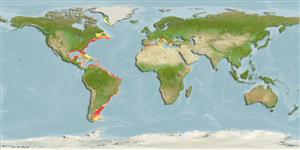Common names from other countries
Issue
Some information are attached to E. jacksoniensis Macleay, 1878, a synonym of Etrumeus (Ref. 93002).
Environment: milieu / climate zone / depth range / distribution range
Ecologia
marino; oceanodromo (Ref. 51243); distribuzione batimetrica 0 - 125 m (Ref. 96339). Subtropical
Restricted to the northwestern Atlantic: from the Bay of Fundy to the Gulf of Mexico.
Length at first maturity / Size / Peso / Age
Maturity: Lm 17.0 range ? - ? cm
Max length : 33.0 cm TL maschio/sesso non determinato; (Ref. 56557); common length : 25.0 cm TL maschio/sesso non determinato; (Ref. 56557)
Spine dorsali (totale) : 0; Raggi dorsali molli (totale) : 15 - 18; Spine anali: 0; Raggi anali molli: 10 - 13. Some variation in body depth and certain meristic characters; without pre- and post-pelvic scutes; W-shaped pelvic scute; pelvic fins less advanced. Distinguished from E. whiteheadi of southern African waters by having fewer anal fin rays and the pelvic fin base about 1/3 eye diameter. Isthmus with lateral flanges or shoulders (Ref. 188). Silvery with an olive green back. Scales deciduous (Ref. 7251). Also Ref. 3259.
Mainly inshore but has been occasionally taken 120 km from the Ecuador coast (Ref. 9291); also occur on shelf edge or surface (Ref. 11230), and between 50-150m (Ref. 028016). Usually occur in large schools (Ref. 2850). Epipelagic (Ref. 58302). Feed mainly on euphausiids and copepods (Ref. 9291). Oviparous, with planktonic eggs and larvae (Ref. 35601). Marketed fresh, salted and canned. Also processed into fishmeal (Ref. 9291).
DiBattista, J.D., J.E. Randall and B.W. Bowen, 2012. Review of the round herrings of the genus Etrumeus (Clupeidae: Dussumieriinae) of Africa, with descriptions of two new species. Cybium 36(3):447-460. (Ref. 91762)
IUCN Red List Status (Ref. 130435)
CITES (Ref. 128078)
Not Evaluated
Threat to humans
Harmless
Human uses
Pesca: elevato interesse commerciale
Strumenti
Special reports
Download XML
Fonti Internet
Estimates based on models
Preferred temperature (Ref.
115969): 7.3 - 26.7, mean 20.3 (based on 800 cells).
Phylogenetic diversity index (Ref.
82804): PD
50 = 0.5098 [Uniqueness, from 0.5 = low to 2.0 = high].
Bayesian length-weight: a=0.00589 (0.00329 - 0.01054), b=3.09 (2.92 - 3.26), in cm Total Length, based on LWR estimates for this species & (Sub)family-body (Ref.
93245).
Trophic level (Ref.
69278): 3.6 ±0.2 se; based on diet studies.
Resilienza (Ref.
120179): Medio, tempo minimo di raddoppiamento della popolazione 1.4 - 4.4 anni (K=0.13-0.8; tm=1.7; tmax=5).
Fishing Vulnerability (Ref.
59153): Low vulnerability (16 of 100).
Climate Vulnerability (Ref.
125649): Low vulnerability (6 of 100).
